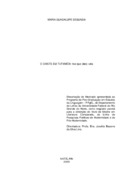Please use this identifier to cite or link to this item:
https://repositorio.ufrn.br/handle/123456789/16163| Title: | O chiste em Tutaméia: riso que (des)vela |
| Authors: | Guadalupe Segunda, Maria |
| Advisor: | Lino, Joselita Bezerra da Silva |
| Keywords: | Chiste;Riso;Inconsciente;Narrativa;Oralidade;Laughter;Unconscious mind;Narration;Orallity |
| Issue Date: | 8-Oct-2009 |
| Publisher: | Universidade Federal do Rio Grande do Norte |
| Citation: | GUADALUPE SEGUNDA, Maria. O chiste em Tutaméia: riso que (des)vela. 2009. 184 f. Dissertação (Mestrado em Linguística Aplicada; Literatura Comparada) - Universidade Federal do Rio Grande do Norte, Natal, 2009. |
| Portuguese Abstract: | Esta dissertação tem como objeto de estudo a análise do chiste em Tutaméia, de João Guimarães Rosa, a partir dos 04 (quatro) prefácios e 10 (dez) contos selecionados da obra. Apresenta como principal referência a teoria psicanalítica sobre o chiste e o inconsciente, de Sigmund Freud e Jacques Lacan. Ao lado do chiste como fio condutor do estudo, é abordada a questão da narrativa como uma estética fundamentada na multiplicidade de vozes do narrador, na oralidade dos folhetos de cordel, intermediada por uma intertextualidade entre a tradição culta e a tradição popular, em que se sobressai uma lógica lingüística e conceitual às avessas, ao contrário dos cânones oficiais da língua. Por fim, é estabelecida uma análise comparativa entre a concepção de vida dos personagens rabelaisianos e alguns personagens de Tutaméia, tendo como paradigma o personagem de Melim-Meloso, através do qual a alegria de viver sobrepõe-se a todas as adversidades da vida, veiculando a mensagem de que o chiste, o riso, é o melhor antídoto contra as dores e pesares da travessia humana, encontrando-se a serviço de uma maior liberdade e prazer de criação |
| Abstract: | The aim of this paper is to present the study of the laughter in Tutaméia, by João Guimarães Rosa, throughtout the four forewords and ten novels selected from the author s literary work. It is based on the psychoanalytical theory of Sigmund Freud and Jacques Lacan about the laughter (and delight in the humorous nuances) and the unconscious mind. By taking the laughter as the point of exploitation and understanding, the narration can be understood from an esthetical pattern established on the variety of orallity retained by the narrator and the cordel pamphlets (known as string literature ) and its bypassing on the classical literature and the popular literature revealing its own logical linguistic and conception apart from the official one. It is taken a comparative conception of life in the François Rabelais characters and some characters from Tutaméia having Melim-Meloso as a paradigm showing how one s life can be happy in spite of all adversities by using laughter as the antidote potion against human being s misery and pain to achieve sense of freedom and pleasure |
| URI: | https://repositorio.ufrn.br/jspui/handle/123456789/16163 |
| Appears in Collections: | PPGEL - Mestrado em Estudos da Linguagem |
Files in This Item:
| File | Description | Size | Format | |
|---|---|---|---|---|
| MariaGSpdf.pdf | 3,21 MB | Adobe PDF |  View/Open |
Items in DSpace are protected by copyright, with all rights reserved, unless otherwise indicated.

